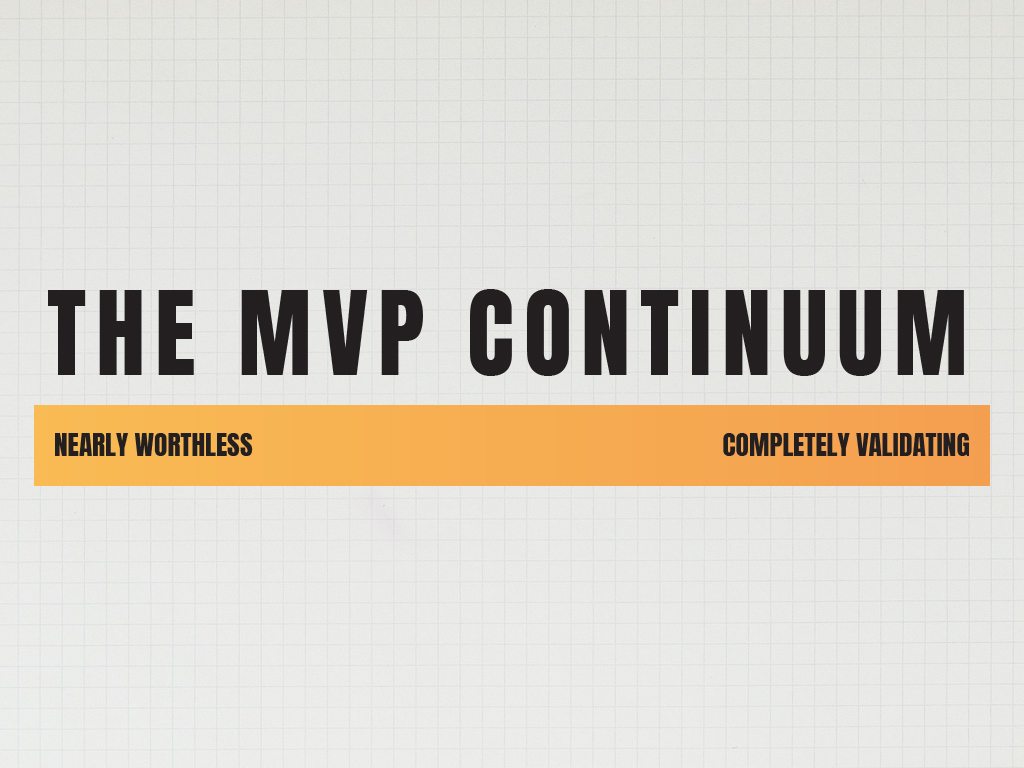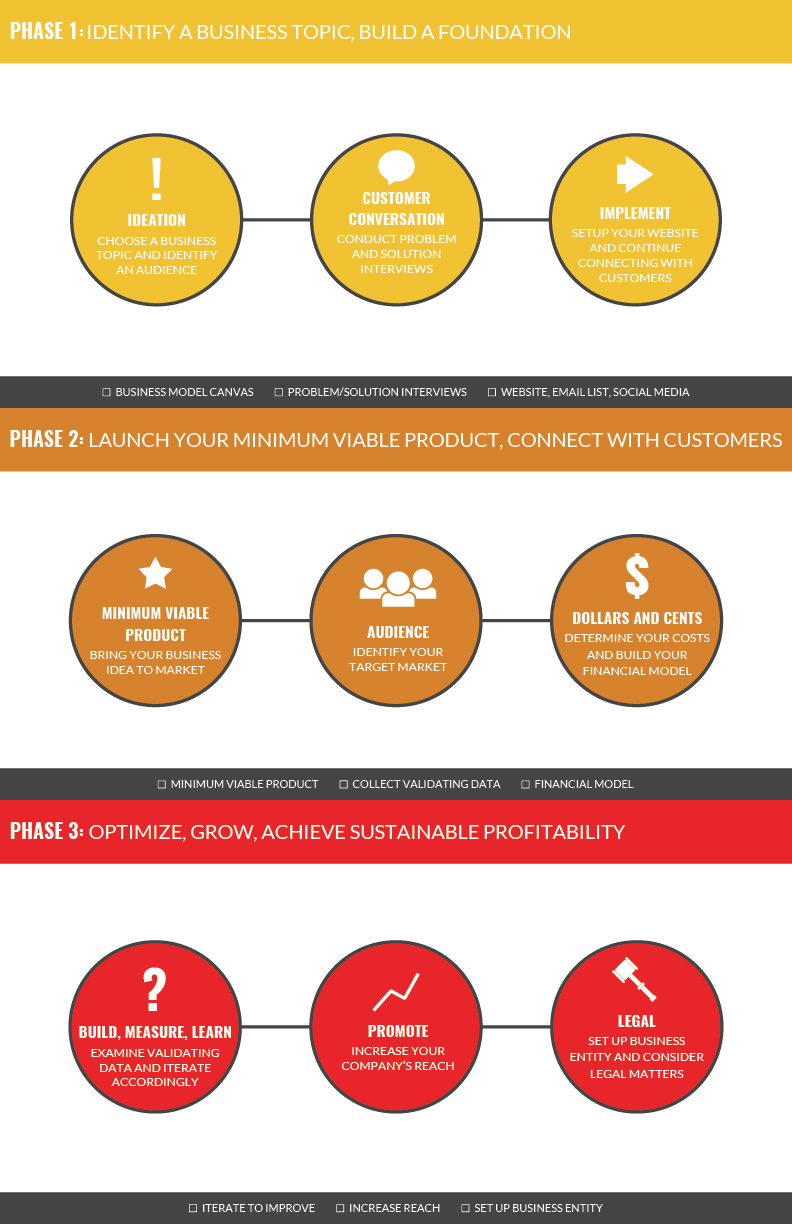Minimum Viable Product Tips
The Minimum Viable Product Continuum
All MVPs fall somewhere on the continuum between nearly useless and completely validating. If your students’ MVP only measures “vanity metrics,” it’s likely closer to the left side of the continuum than the right. It’s easy for your students to say, “We’re going to measure page views to quantify interest in our product or service,” and your students might even drive an impressive number of visitors to their site, but page views alone offer little to no context. Fortunately, by adding a second measure—a call to action in the form of an email optin—it’s possible to move further right on the continuum.

Your students may not understand how significant the quality of their data is when validating their business idea. It may be a good idea to facilitate whole group discussion around this topic using the landing page example illustrated previously to explore the difference. Most importantly, ensure that your students build an MVP that actually tests the core assumptions of their business idea.
Focus On What Matters
Students love this portion of class, because it involves actually bring their visions to life. Unfortunately, some students will get wrapped up in all of the wrong activities. For instance, if a team is building a web page as part of their MVP, they might decide that they need a logo. If you’re not carefully observing what that team is doing, they may very well spend an entire week making that logo look perfect, but a logo is not an MVP. It will not validate a team’s core assumptions
“A logo is not an MVP”
No team should spend more than five minutes on a logo during this phase. If the team absolutely needs one, have them use the link below to the Google Word Art template to create a simple design that uses a semi-bold font like “Anton” and alternates fill and stroke color on each word as in the example below.

- Website Logo Template
- Visit the following link to view a “Word Art” tutorial: https://youtu.be/oVP3byR2zBs
Sell Something
I tell my students that the best way that they can validate their business idea is by actually selling their product or service to someone. I understand that not all business ideas can be built to a point where a transaction is feasible, but my experience has been that servicing even a few customers is more valuable than collecting survey data on hundreds. If there exists a means by which your students can actually charge money for their good or service, this will more definitively confirm or refute the assumptions they have made about their business.
One other note on this point: buy encouraging your students to actually complete a transaction, it will force them to keep the scope of their project in check with reality. I’ve written more about this topic here: The Sweet Spot.
Minimum Viable Product Time Management
I build a lot of time into the instructional calendar for the minimum viable product design unit. Building an MVP that provides informative, useful data is a process that simply can’t be rushed. If you’re in the process of scheduling your classes (or scheduling as you go…), add as much time to this unit as you possibly can. I guarantee you will use all of it.
On the first day of MVP design instruction, I share a calendar with my students that culminates with the MVP Pitch event. At the beginning of each class, I review the calendar to hammer into my students minds that the pitch will be here before they know it. In that allotted time, they need to design an MVP, build it, start to test it, AND prepare a pitch presentation. Two and a half to three weeks might sound like a lot of time, but it expires incredibly rapidly.
Pivoting
Through this process, some of your teams will discover that their business idea is, and this is a technical term, “not good.” Perhaps due to a product, market, or customer risk, some of your students may come to the conclusion that their business idea is not worth their efforts. This can be incredibly deflating for the students (and maybe for you too), but remember your commitment to the Build > Measure > Learn feedback loop. Your students haven’t failed at building a business, they’ve succeeded in ruling out an ineffective model for a business. They’re one step closer to success!
Edisonian mind tricks aside, this is a very real part of this class. A number of your students will, at some point, be faced with having to make a late stage pivot. Encourage those students to revisit their Passions, Problems, and Tribes worksheets from the Unit 1. See if any of their previous ideas are more appealing now that they know what they know. Give them an opportunity to go through ideation exercises again. Depending on class and group size, you may even consider modifying team formation.
Once your students identify a new idea, they will have to conduct an abbreviated version of all of the activities from this course to this point. This may seem overwhelming at first, but since it’s the second time through, a team can divide and conquer to complete each of the primary tasks listed below.
- Complete the BMC
- Conduct Problem and Solution Interviews
- Procure social media accounts and start to build website
- Design a new MVP
- Test to validate or refute assumptions
For a handy visual aid, I’ve created the “Pivot Checklist” below that you can also download as a tabloid sized PDF here: Pivot_Checklist.pdf

Conclusion
You’ll likely feel overwhelmed at some point during this phase, but take comfort in knowing that it gets easier the next time around if you take note of what worked well and what didn’t. This way, you can guide your future groups towards what works and steer them away from that which will present insurmountable challenges later on.
Minimum Viable Product Tips
The Minimum Viable Product Continuum
All MVPs fall somewhere on the continuum between nearly useless and completely validating. If your students’ MVP only measures “vanity metrics,” it’s likely closer to the left side of the continuum than the right. It’s easy for your students to say, “We’re going to measure page views to quantify interest in our product or service,” and your students might even drive an impressive number of visitors to their site, but page views alone offer little to no context. Fortunately, by adding a second measure—a call to action in the form of an email optin—it’s possible to move further right on the continuum.

Your students may not understand how significant the quality of their data is when validating their business idea. It may be a good idea to facilitate whole group discussion around this topic using the landing page example illustrated previously to explore the difference. Most importantly, ensure that your students build an MVP that actually tests the core assumptions of their business idea.
Focus On What Matters
Students love this portion of class, because it involves actually bring their visions to life. Unfortunately, some students will get wrapped up in all of the wrong activities. For instance, if a team is building a web page as part of their MVP, they might decide that they need a logo. If you’re not carefully observing what that team is doing, they may very well spend an entire week making that logo look perfect, but a logo is not an MVP. It will not validate a team’s core assumptions
“A logo is not an MVP”
No team should spend more than five minutes on a logo during this phase. If the team absolutely needs one, have them use the link below to the Google Word Art template to create a simple design that uses a semi-bold font like “Anton” and alternates fill and stroke color on each word as in the example below.

- Website Logo Template
- Visit the following link to view a “Word Art” tutorial: https://youtu.be/oVP3byR2zBs
Sell Something
I tell my students that the best way that they can validate their business idea is by actually selling their product or service to someone. I understand that not all business ideas can be built to a point where a transaction is feasible, but my experience has been that servicing even a few customers is more valuable than collecting survey data on hundreds. If there exists a means by which your students can actually charge money for their good or service, this will more definitively confirm or refute the assumptions they have made about their business.
One other note on this point: buy encouraging your students to actually complete a transaction, it will force them to keep the scope of their project in check with reality. I’ve written more about this topic here: The Sweet Spot.
Minimum Viable Product Time Management
I build a lot of time into the instructional calendar for the minimum viable product design unit. Building an MVP that provides informative, useful data is a process that simply can’t be rushed. If you’re in the process of scheduling your classes (or scheduling as you go…), add as much time to this unit as you possibly can. I guarantee you will use all of it.
On the first day of MVP design instruction, I share a calendar with my students that culminates with the MVP Pitch event. At the beginning of each class, I review the calendar to hammer into my students minds that the pitch will be here before they know it. In that allotted time, they need to design an MVP, build it, start to test it, AND prepare a pitch presentation. Two and a half to three weeks might sound like a lot of time, but it expires incredibly rapidly.
Pivoting
Through this process, some of your teams will discover that their business idea is, and this is a technical term, “not good.” Perhaps due to a product, market, or customer risk, some of your students may come to the conclusion that their business idea is not worth their efforts. This can be incredibly deflating for the students (and maybe for you too), but remember your commitment to the Build > Measure > Learn feedback loop. Your students haven’t failed at building a business, they’ve succeeded in ruling out an ineffective model for a business. They’re one step closer to success!
Edisonian mind tricks aside, this is a very real part of this class. A number of your students will, at some point, be faced with having to make a late stage pivot. Encourage those students to revisit their Passions, Problems, and Tribes worksheets from the Unit 1. See if any of their previous ideas are more appealing now that they know what they know. Give them an opportunity to go through ideation exercises again. Depending on class and group size, you may even consider modifying team formation.
Once your students identify a new idea, they will have to conduct an abbreviated version of all of the activities from this course to this point. This may seem overwhelming at first, but since it’s the second time through, a team can divide and conquer to complete each of the primary tasks listed below.
- Complete the BMC
- Conduct Problem and Solution Interviews
- Procure social media accounts and start to build website
- Design a new MVP
- Test to validate or refute assumptions
For a handy visual aid, I’ve created the “Pivot Checklist” below that you can also download as a tabloid sized PDF here: Pivot_Checklist.pdf

Conclusion
You’ll likely feel overwhelmed at some point during this phase, but take comfort in knowing that it gets easier the next time around if you take note of what worked well and what didn’t. This way, you can guide your future groups towards what works and steer them away from that which will present insurmountable challenges later on.


0 Comments